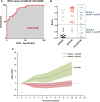A circulating exosomal microRNA panel as a novel biomarker for monitoring post-transplant renal graft function
- PMID: 32918330
- PMCID: PMC7579686
- DOI: 10.1111/jcmm.15861
A circulating exosomal microRNA panel as a novel biomarker for monitoring post-transplant renal graft function
Abstract
Accurate and effective biomarkers for continuous monitoring of graft function are needed after kidney transplantation. The aim of this study was to establish a circulating exosomal miRNA panel as non-invasive biomarker for kidney transplant recipients. Plasma exosomes of 58 kidney transplant recipients and 27 healthy controls were extracted by gel exclusion chromatography and characterized by transmission electron microscopy, nanoparticle tracking analysis and Western blotting. Post-transplant renal graft function was evaluated by estimated glomerular filtration rate (eGFR). Quantitative real-time polymerase chain reaction was used to determine the expression of exosomal microRNAs (miRNAs). Exosomal miR-21, miR-210 and miR-4639 showed negative correlations with eGFR in the training set and were selected for further analysis. In the validation set, miR-21, miR-210 and miR-4639 showed the capability to discriminate between subjects with chronic allograft dysfunction (eGFR < 60 mL/min/1.73 m2 ) and those with normal graft function (eGFR > 90 mL/min/1.73 m2 ). Three-miRNA panel exhibited higher accuracy compared with individual miRNAs or double indicators. One-year follow-up revealed a stable recovery of allograft function in subjects with low calculated score from three-miRNA panel (below the optimal cut-off value). In conclusion, a unique circulating exosomal miRNA panel was identified as an effective biomarker for monitoring post-transplant renal graft function in this study.
Keywords: MicroRNAs; biomarker; estimated glomerular filtration rate; exosomes; kidney transplant.
© 2020 The Authors. Journal of Cellular and Molecular Medicine published by Foundation for Cellular and Molecular Medicine and John Wiley & Sons Ltd.
Conflict of interest statement
The authors confirm that there are no conflicts of interest. The authors had full access to all of the data in this study and take complete responsibility for the integrity of the data and the accuracy of the data analysis.
Figures





Similar articles
-
Upregulated Expression of Circulating MicroRNAs in Kidney Transplant Recipients With Interstitial Fibrosis and Tubular Atrophy.Iran J Kidney Dis. 2017 Jul;11(4):309-318. Iran J Kidney Dis. 2017. Retraction in: Iran J Kidney Dis. 2017 Oct;11(5):393. PMID: 28794294 Retracted.
-
Cell-free microRNA-148a is associated with renal allograft dysfunction: Implication for biomarker discovery.J Cell Biochem. 2019 Apr;120(4):5737-5746. doi: 10.1002/jcb.27860. Epub 2018 Oct 15. J Cell Biochem. 2019. PMID: 30320905
-
Circulating miR-150, miR-192, miR-200b, and miR-423-3p as Non-invasive Biomarkers of Chronic Allograft Dysfunction.Arch Med Res. 2017 Jan;48(1):96-104. doi: 10.1016/j.arcmed.2017.03.004. Arch Med Res. 2017. PMID: 28577875
-
Circulating Exosomal miRNAs as Biomarkers for the Diagnosis and Prognosis of Colorectal Cancer.Int J Mol Sci. 2020 Dec 31;22(1):346. doi: 10.3390/ijms22010346. Int J Mol Sci. 2020. PMID: 33396209 Free PMC article. Review.
-
The potential prognostic and therapeutic application of tissue and circulating microRNAs in cervical cancer.J Cell Physiol. 2019 Feb;234(2):1289-1294. doi: 10.1002/jcp.27160. Epub 2018 Sep 7. J Cell Physiol. 2019. PMID: 30191988 Review.
Cited by
-
Diagnostic value of circulating microRNA-21 in chronic lung allograft dysfunction after bilateral cadaveric and living-donor lobar lung transplantation.Heliyon. 2023 Mar 25;9(4):e14903. doi: 10.1016/j.heliyon.2023.e14903. eCollection 2023 Apr. Heliyon. 2023. PMID: 37025782 Free PMC article.
-
The Application of Nanoparticles in Diagnosis and Treatment of Kidney Diseases.Int J Mol Sci. 2021 Dec 23;23(1):131. doi: 10.3390/ijms23010131. Int J Mol Sci. 2021. PMID: 35008556 Free PMC article. Review.
-
Extracellular vesicles in kidney development and pediatric kidney diseases.Pediatr Nephrol. 2024 Jul;39(7):1967-1975. doi: 10.1007/s00467-023-06165-9. Epub 2023 Sep 29. Pediatr Nephrol. 2024. PMID: 37775581 Free PMC article. Review.
-
Epigenetic Regulation in Kidney Transplantation.Front Immunol. 2022 Apr 8;13:861498. doi: 10.3389/fimmu.2022.861498. eCollection 2022. Front Immunol. 2022. PMID: 35464484 Free PMC article. Review.
-
What do we actually know about exosomal microRNAs in kidney diseases?Front Physiol. 2022 Aug 29;13:941143. doi: 10.3389/fphys.2022.941143. eCollection 2022. Front Physiol. 2022. PMID: 36105281 Free PMC article. Review.
References
-
- Leeson S, Desai SP. Medical and ethical challenges during the first successful human kidney transplantation in 1954 at Peter Bent Brigham Hospital, Boston. Anesth Analg. 2015;120:239‐245. - PubMed
-
- Schauerte C, Hubner A, Rong S, et al. Antagonism of profibrotic microRNA‐21 improves outcome of murine chronic renal allograft dysfunction. Kidney Int. 2017;92:646‐656. - PubMed
-
- Zununi Vahed S, Poursadegh Zonouzi A, Mahmoodpoor F, et al. Circulating miR‐150, miR‐192, miR‐200b, and miR‐423‐3p as non‐invasive biomarkers of chronic allograft dysfunction. Arch Med Res. 2017;48:96‐104. - PubMed
-
- Mannon RB, Kirk AD. Beyond histology: novel tools to diagnose allograft dysfunction. Clin J Am Soc Nephrol. 2006;1:358‐366. - PubMed
Publication types
MeSH terms
Substances
LinkOut - more resources
Full Text Sources
Other Literature Sources
Medical
Research Materials
Miscellaneous

